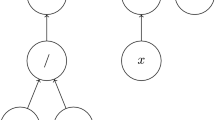Abstract
This paper is about a property of certain combinatorial structures, called sequential convexifiability, shown by Balas (1974, 1979) to hold for facial disjunctive programs. Sequential convexifiability means that the convex hull of a nonconvex set defined by a collection of constraints can be generated by imposing the constraints one by one, sequentially, and generating each time the convex hull of the resulting set. Here we extend the class of problems considered to disjunctive programs with infinitely many terms, also known as reverse convex programs, and give necessary and sufficient conditions for the solution sets of such problems to be sequentially convexifiable. We point out important classes of problems in addition to facial disjunctive programs (for instance, reverse convex programs with equations only) for which the conditions are always satisfied. Finally, we give examples of disjunctive programs for which the conditions are violated, and so the procedure breaks down.
Similar content being viewed by others
References
M. Avriel,Nonlinear Programming: Analysis and Methods (Prentice Hall, Englewood Cliffs, NJ, 1976).
E. Balas, “Disjunctive programming: Properties of the convex Hull of feasible points,” MSRR No. 348, Carnegie Mellon University (Pittsburgh, PA, 1974).
E. Balas, “Disjunctive programming,”Annals of Discrete Mathematics 5 (1979) 3–51.
E. Balas, “On the facial structure of scheduling polyhedra,”Mathematical Programming Study 24 (1985) 179–218.
C.E. Blair and R.G. Jeroslow, “Extensions of a theorem of Balas,”Discrete Applied Mathematics 9 (1984) 11–26.
R.J. Hillestad and S.E. Jacobsen, “Reverse convex programming,”Applied Mathematics and Optimization 6 (1980) 63–78.
R.G. Jeroslow, “A cutting plane game for facial disjunctive programs,”SIAM Journal on Control and Optimization 18 (1980) 264–281.
R.T. Rockafellar,Convex Analysis (Princeton University Press, Princeton, NJ, 1970).
J.B. Rosen, “Iterative solution of nonlinear optimal control problems,”SIAM Journal on Control 4 (1966) 223–244.
S. Sen and H.D. Sherali, “Nondifferentiable reverse convex programs and facetial convexity cuts via a disjunctive characterization,”Mathematical Programming 37 (1987) 169–183.
H. Tuy, “Global minimization of a concave function subject to mixed linear and reverse convex constraints,” Institute of Mathematics (Hanoi, Vietnam). To appear in Proceedings of the IFIP Conference on “Recent Advances in System Modelling and Optimization,” Hanoi, 1983.
Author information
Authors and Affiliations
Additional information
The research underlying this report was supported by Grant ECS-8601660 of The National Science Foundation and Contract N00014-85-K-0198 with the Office of Naval Research. Reproduction in whole or in part is permitted for any purpose of the U.S. Government.
On leave from the University of Aarhus, Denmark.
Rights and permissions
About this article
Cite this article
Balas, E., Tama, J.M. & Tind, J. Sequential convexification in reverse convex and disjunctive programming. Mathematical Programming 44, 337–350 (1989). https://doi.org/10.1007/BF01587096
Received:
Revised:
Issue Date:
DOI: https://doi.org/10.1007/BF01587096



